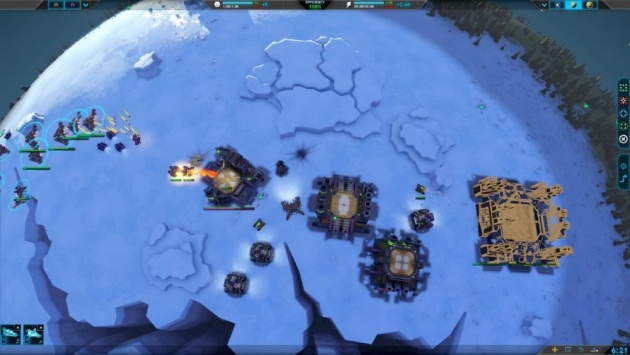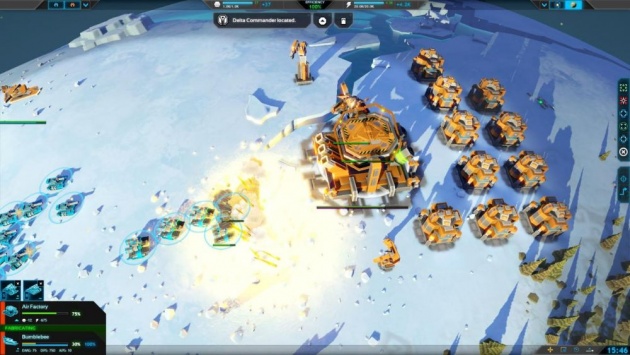Total Annihilation goes intergalactic, and at hyperspeed. That, in a nutshell, describes Planetary Annihilation, Uber Entertainment's homage to one of the all-time greatest real-time strategy games. The game comes with some key enhancements, however, including a challenging pace and enemy artificial intelligence, along with full globes of cartoony planets and moons serving as battlegrounds. RTS newcomers will have a tough time with the sheer velocity of the combat and the lack of proper tutorials and manuals, as will tacticians who prefer to think before they click. But the speed, difficulty, and map innovations make Planetary Annihilation grow on you.
I wouldn't have said so in the early hours, though. Planetary Annihilation steamrolled me initially. The game comes with little in the way of documentation. There is no in-game tutorial; all the primers that you get before being dropped on a planet come from blurry videos that barely hint at what the game has to offer. To figure things out, you should watch an hour or three of YouTube videos and search the Internet for tips. Until you research, you are cannon fodder on map after map. Planetary Annihilation desperately needs a proper tutorial that lets players dip their toes into the deep waters; the "jump in head-first" approach doesn't work with a game this unforgiving.

The underlying RTS formula is familiar, at least. As in Total Annihilation, you start off with a giant commander that has the power to construct various parts of your headquarters, including vehicle and robot builders, power plants (energy is one resource), metal extractors (metal is the other), laser turrets, and so forth. Every faction is led by one of these bosses, so victory comes when you blast these Transformer wannabes into rubble. There is a simple progression here. You start with your commander and then create a fabricator vehicle with access to even more facility blueprints and improved factories that can crank out bigger and better tanks, planes, bots, ships, and orbital weaponry and vessels. Then you create advanced versions of all this stuff that handle heavier duties that lead to even more formidable armies.
Planetary Annihilation sticks you into a quick-tempo arms race that rolls from planet to planet, from moon to moon. From the moment that your big robot commander hits the ground, you need to establish facilities and ensure that you have a production line running at maximum efficiency. Units need to be streaming out continuously, and knowledge of hotkeys is imperative, especially when the guns start going off. The enemy AI always gets its armies flowing quickly, so taking extra time to play with the mouse or contemplate what type of tank would be most useful in the current situation results in being besieged and obliterated. You don't even have any time to spare when the foe is a planet or two away, as the bad guys rapidly send a transport your way and then build the transporter needed to beam full armies to your front door.

Foes can attack from any direction. Unlike other RTS games with traditional flat maps, the battlegrounds here are full globes. Planets look rather cartoony, as they are extremely tiny, your units are spectacularly huge, or both. But they form effective theaters of war and feature various types of terrain ranging from ice balls, to desert worlds, to chunks of metal. It’s hard to get used to at first; RTS instinct might have you building defenses between your bases and the enemy, forgetting that all opponents must do to flank is to simply run around the globe. This strategic consideration caught me off guard in the early stages, and forced me to spend more time walling off bases and ensuring that I had proper turret protection all the way around against ground and aerial assaults.
Make sure to build defenses again orbital attacks, too. As you might expect from a game where you conquer planets and moons, space is a key dimension in addition to the traditional land, air, and sea units. Orbital constructors crank out spaceships like fighters and transport vessels necessary to launch interplanetary invasions (although transporters make it easy to teleport armies across the void instantaneously after you establish a beachhead). This whole concept is initially befuddling; AI makes full use of space attacks, so you might be convinced at first that some buildings are blowing up on their own. Once you surmount that learning curve and stage an invasion, however, the course of battle becomes easier to understand. There is also the ability to build Death Stars by fitting guns into metal worlds and crashing one planetary body into another, giving matches a suitably apocalyptic feel.
The AI is cunning and spectacularly aggressive. It builds quickly, creates a solid base infrastructure with loads of power plants and metal extractors, and immediately sets forth to crush all opposition. It is smart at reacting to your defenses. Build a ton of anti-air defenses to deal with enemy planes, and the AI will quickly react by throwing more tanks and ships at you. Any vulnerability is identified and attacked, even on the default normal difficulty, making the challenge occasionally difficult to take. You might get a base set up, think you have everything covered, and be ready to roll out enough fighters and bombers to blot out the sky, only to be steadily whittled away by probing enemy strikes that are inevitably followed up by massive waves of units.
An easier difficulty setting might have provided time to get fully accustomed to the interface and then ramp up the speed, but its global battles can get under your skin, keeping you coming back for more and more. Planetary Annihilation is a good, challenging RTS designed along very familiar lines. True, its best qualities can be obscured in the early going by its unforgiving difficulty and the absence of good tutorials, but even when you're overwhelmed, speedy combat and smart AI reel you in. Give it time, and the fast and furious combat smooth out the rough edges into a compelling and challenging strategy game.



